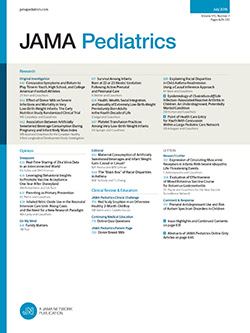Sexual Health of US Transgender Boys, Nonbinary Youth, and Cisgender Girls.
IF 24.7
1区 医学
Q1 PEDIATRICS
引用次数: 0
Abstract
Importance Research documenting the pregnancy experiences of transgender boys and nonbinary youth assigned female at birth (AFAB) in the US is lacking. Objective To examine AFAB youth sexual health indicators by gender. Design, Setting, Participants Self-reported data were collected cross-sectionally from 2018 through 2020. Initial analyses were conducted in 2023 and analyses were finalized in September 2024. The study took place online, across the 50 US states and Washington, DC. Eligible participants were 14 to 16 years old, read English, and had internet access. Main Outcome Sexual health (ie, self-reported pregnancy and sexually transmitted infections [STIs] lifetime prevalence, condom use, and use of other forms of birth control at last penile-vaginal or penile-anal sex). Results Based on weighted data (sample sizes are unweighted), 2109 cisgender girls, 348 transgender boys, and 458 nonbinary AFAB youth were included in analyses. There were 44 transgender boys (14%; 95% CI, 9.4-20.1; P = .24), 67 AFAB nonbinary youth (14%; 95% CI, 10.8-18.8; P = .18), and 397 cisgender girls (18%; 95% CI, 16.0-19.7) who reported ever having penile-vaginal sex. Rates for penile-anal sex were also similar by gender (4% to 6%). Lifetime pregnancy rates were higher for transgender boys (5 [9%]; 95% CI, 2.7-27.1; P = .23) than cisgender (18 [4%]; 95% CI, 2.5-7.1) girls, although not statistically significantly so. Pregnancy rates were similar for AFAB nonbinary youth (5 [5%]; 95% CI, 1.9-13.3; P = .73) compared with cisgender girls. Lifetime STI rates were universally low for all AFAB youth (0.5% to 2.0%). Mean age at first penile-vaginal sex was lower for AFAB nonbinary youth (mean age, 13.6 years; SE, 0.4; P = .003) and transgender boys (mean age, 13.9 years; SE, 0.3; P = .06) compared with cisgender girls (mean age, 14.4 years; SE, 0.1). Condom use at last penile-anal or penile-vaginal sex for transgender boys (24 [16%]; 95% CI, 9.5-27.0; P < .001) and AFAB nonbinary youth (33 [24%]; 95% CI, 16.4-34.2; P < .001) was half that of cisgender girls (245 [49%]; 95% CI, 44.1-54.2). Use of birth control other than condoms at last sex was lower for AFAB nonbinary youth (18 [28%]; 95% CI, 16.2-44.5; P = .14), but similar for transgender boys (20 [42%]; 95% CI, 23.4-62.4; P = .69) compared with cisgender girls (167 [44%]; 95% CI, 38.6-50.0). Conclusion and Relevance In this cross-sectional study of sexual health among AFAB youth with a diversity of gender identities, transgender boys were more likely, and nonbinary youth, similarly likely, as cisgender girls to be pregnant during adolescence. Even though overall rates of penile-vaginal sex were similar for transgender boys and AFAB nonbinary youth compared with cisgender girls, half as many transgender boys and AFAB nonbinary youth who had this type of sex used a condom at last sex compared with cisgender girls. As with cisgender girls, transgender boys and AFAB nonbinary youth need to be engaged in affirming and inclusive sexual health education.美国变性男孩、非二元性青年和顺性女孩的性健康
在美国,关于变性男孩和非二元性别青少年出生时分配的女性(AFAB)怀孕经历的研究缺乏。目的按性别对AFAB青少年性健康指标进行调查。设计、环境、参与者自我报告的数据是在2018年至2020年期间横断面收集的。初步分析于2023年进行,分析于2024年9月完成。这项研究在美国50个州和华盛顿特区进行了在线调查。符合条件的参与者年龄在14到16岁之间,能读英语,能上网。主要结果:性健康(即自我报告的怀孕和性传播感染终生发病率、避孕套的使用以及最后阴茎-阴道性交或阴茎-肛门性交时使用其他形式的节育措施)。结果基于加权数据(样本量未加权),分析纳入了2109名顺性别女孩,348名变性男孩和458名非二元AFAB青年。有44名变性男孩(14%;95% ci, 9.4-20.1;P = 0.24), 67名AFAB非二元青年(14%;95% ci, 10.8-18.8;P = .18), 397名顺性别女孩(18%;95% CI, 16.0-19.7),报告有过阴茎-阴道性交。阴茎-肛交的比例在性别上也相似(4%到6%)。变性男孩终生妊娠率较高(5 [9%];95% ci, 2.7-27.1;P = .23)高于顺性别(18 [4%];95% CI, 2.5-7.1)女孩,尽管没有统计学上的显著差异。AFAB非二元青年的妊娠率相似(5 [5%];95% ci, 1.9-13.3;P = .73)。所有AFAB青年的终生性传播感染发生率普遍较低(0.5%至2.0%)。AFAB非二元青年发生第一次阴茎-阴道性行为的平均年龄较低(平均年龄13.6岁;, 0.4;P = 0.003)和变性男孩(平均年龄13.9岁;, 0.3;P = .06),与顺性别女童相比(平均年龄14.4岁;, 0.1)。变性男孩在阴茎-肛门性交或阴茎-阴道性交中最后使用避孕套(24 [16%];95% ci, 9.5-27.0;P < 0.001)和AFAB非二元青年(33 [24%];95% ci, 16.4-34.2;P < 0.001)为顺性女孩的一半(245例[49%];95% ci, 44.1-54.2)。AFAB非二元青年在最后性行为中使用避孕套以外的避孕措施的比例较低(18 [28%];95% ci, 16.2-44.5;P = .14),但跨性别男孩相似(20 [42%];95% ci, 23.4-62.4;P = 0.69),而顺性别女孩(167例[44%];95% ci, 38.6-50.0)。结论和相关性:在这项性别认同多样化的AFAB青少年性健康的横断面研究中,变性男孩和非二元性别青少年在青春期怀孕的可能性更大,而顺性女孩的可能性相似。尽管与顺性女孩相比,变性男孩和AFAB非二元性青少年的阴茎-阴道性交的总体比例是相似的,但与顺性女孩相比,有这种类型性行为的变性男孩和AFAB非二元性青少年在最后性生活中使用安全套的比例只有一半。与顺性女孩一样,变性男孩和AFAB非二元青年需要参与肯定和包容的性健康教育。
本文章由计算机程序翻译,如有差异,请以英文原文为准。
求助全文
约1分钟内获得全文
求助全文
来源期刊

JAMA Pediatrics
PEDIATRICS-
CiteScore
31.60
自引率
1.90%
发文量
357
期刊介绍:
JAMA Pediatrics, the oldest continuously published pediatric journal in the US since 1911, is an international peer-reviewed publication and a part of the JAMA Network. Published weekly online and in 12 issues annually, it garners over 8.4 million article views and downloads yearly. All research articles become freely accessible online after 12 months without any author fees, and through the WHO's HINARI program, the online version is accessible to institutions in developing countries.
With a focus on advancing the health of infants, children, and adolescents, JAMA Pediatrics serves as a platform for discussing crucial issues and policies in child and adolescent health care. Leveraging the latest technology, it ensures timely access to information for its readers worldwide.
 求助内容:
求助内容: 应助结果提醒方式:
应助结果提醒方式:


